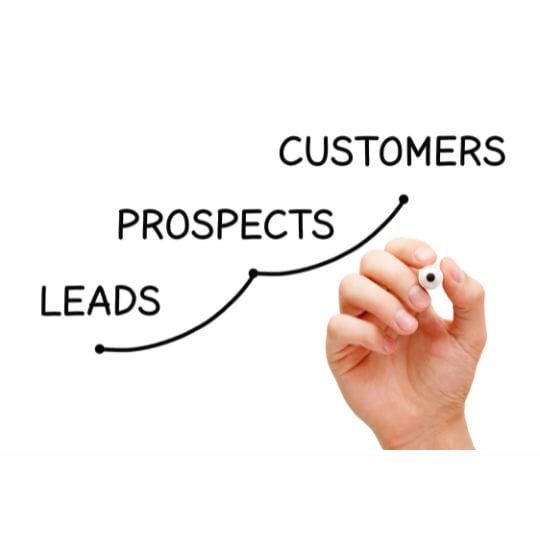
If you’re building business, then you’ll be pursuing new leads and making offers to your growing audience. The surprising thing is, after making an offer or delivering a service, so many people DON’T follow up on their existing leads and customers – yet this is an incredibly cost-effective way to grow your business. Let’s explore how following up grows your business and revenue, and how to create, automate and celebrate your follow-ups!
For so many coaches and other business owners I know, their version of ‘business as usual’ is a kind of set-and-forget approach.
What I mean is, that they go out and meet lots of different people or organisations in an attempt to become known and win work. Or they’re on social media and they put out an offer, and then forget about following up.
In either case, they commonly say things like, ‘If you’re interested, give me a call!’
Why do we do that?
Often, it’s because you don’t want to feel pushy, or salesy. You feel like following might pressure your leads and put them offside.
But think about your own busy life for a minute. How often do you remember to book your next appointment?
And when you’re struggling with something, how easy is it for you to reach out for help?
Do you hate making phone calls?
For me, I book the next appointment when I am in the session, whether it’s a haircut, massage or any other sort of session. I hate making phone calls and am busy – I’d rather be efficient.
And when the car service business reaches out to me, I’m thankful that they’ve prompted me and I book in for a service online. Otherwise, I might not get around to it. Now let’s go back to your customers. You don’t need Harvard Business Review’s insights to know that most people have hundreds of emails in their inbox each day, and spend up to 2.6 hours per day on email.
So the problem is not that people are ignoring you, or resistant, or don’t want what you have to offer. It’s just that they have a lot happening.
Now in the customer’s shoes – how would you feel if you had a great service with someone, but they never followed up to see how you were, or whether you needed help?
One word comes up for me – I’d feel FORGOTTEN.
I’d question my trust in the person who makes an offer and never follows up. I’d wonder how reliable they are, and whether they really care or not.
Online CRM Hubspot cites a study by Brevet, that says:
These are the stats for professional salespeople – what do you think the follow-up rate is for coaches and small business owners?
That’s a lot of money being left on the table.

My Chiropractor friend told me that if an existing customer doesn’t rebook an appointment, he sends out a physical letter, then another, then another – all about a month apart. He says that most people respond and book on the third letter.
One important point about this is that these are the existing customers that he’s re-engaging – not new customers. So, it’s going to be way easier to follow up and secure appointments with them because of the existing relationship.
Of course, if you don’t want to follow up existing leads and clients, you can always start from scratch, put yourself out there again, and spend money on advertising! Who wants to be on that treadmill when you can invest in building more valuable and supportive relationships!
Let’s start from the beginning and talk about setting yourself up for follow-up success.
Before you do any follow-up, you need to make sure that you are getting a direct response from every lead and creating some sort of customer connection – a database, list or group – where you can have regular contact.
What does that mean?

Firstly, it means that everyone who enquires about your business is invited to join your newsletter email list or your online group, or your F2F meetup group, or to follow/subscribe on social media.
Doing this gives you clarity on whether they’re serious about building a relationship with you.
Then, that list, group or following – or whatever it is – is the vehicle that allows you to follow up! Without this ongoing contact opportunity, you’ve got nothing.
The next thing to do is to define your process for following up.
For example, let’s say that someone comes to a live event that you run (e.g. webinar, workshop etc) and you make an offer at the end to join your next program. They’ve never worked with you before.
With all of your leads in one place, I recommend you map out what the next two follow-up steps are for them to work with you will be.

Firstly, make sure you are VERY clear on where you are leading people. What is the follow-up product or service you are offering them?
Then, map out the next actions they will take, and you will take, to engage them with that. Planning this in advance means that you have an intention and are mentally prepared to talk about it effortlessly and with confidence.
Make sure the follow-up steps are active, not passive.
In other words, on the day of the session, let them know what the steps are – and then follow up! Now, when will you follow up, and how?
Some ideas might be:
These are just examples of how you could do this – it’s totally up to you as to what you do exactly.
Here’s another example for existing clients.
Someone completed a coaching program with you two months ago. You want to check in with them and see how they’re doing, and find out if they need any support or a top-up session.
When would you follow up, and how?
Some ideas might be:
Once again, I just made this up.
Come up with your own ideas, considering how you’d like to be treated if you were the client.
The next thing to do is to sketch out your follow-up process (or checklist it), and then create any templates you might need e.g. email templates, message templates etc.
That way, you can easily rinse and repeat your follow-up process, or ask a VA do to it for you!
The next thing to do is to diarise times to follow up, and actually do it.
Maybe you schedule a Friday every three months where you dedicate half a day to phoning or emailing old clients to check in with them.
Maybe you have a dedicated time slot for follow-ups in the three days after you make an offer. This might include your email that goes out, but also answering questions by email or by phone.
Make time for your follow-ups, and therefore, your clients!
Leads and clients are people you already have a relationship with. It means they’re interested in what you do.
If you want to generate more revenue and grow your business, following up is an easy and important process to help you get there.
If you are clear on where people are heading, and what their next steps are, and you have systemised your follow-up (templates, and diarised actions), you’re well on your way to actively building relationships and increasing your revenue.
This is a low-cost way to build a business compared to spending money on advertising and starting from scratch!
Understanding who you are and what you need will allow your business to thrive! If you’re truly ready to break old habits and get out of the rut I encourage you to check out the Habitology membership.
Learn more here: